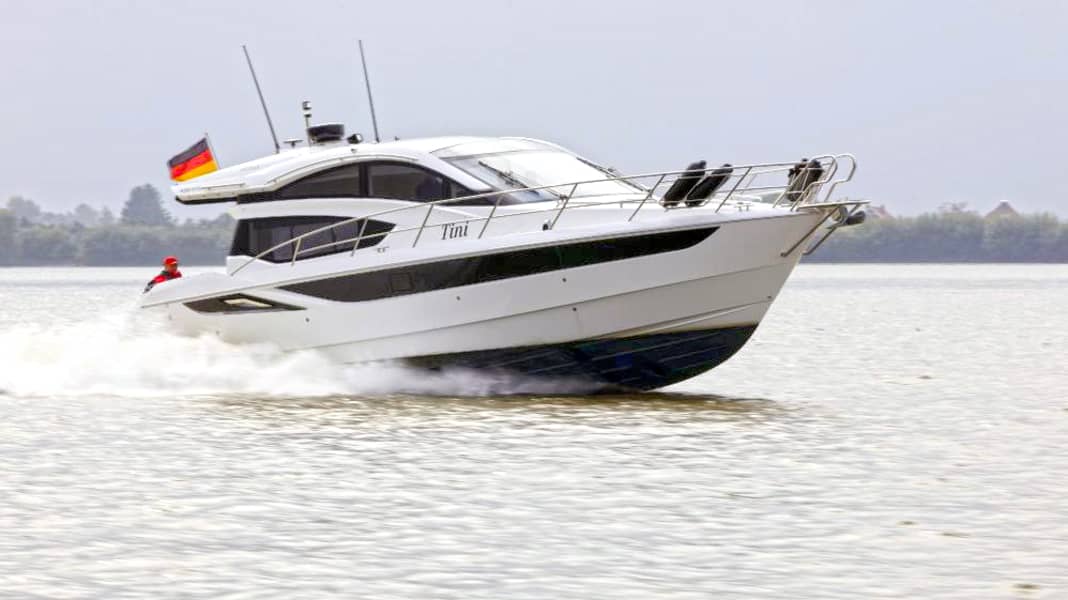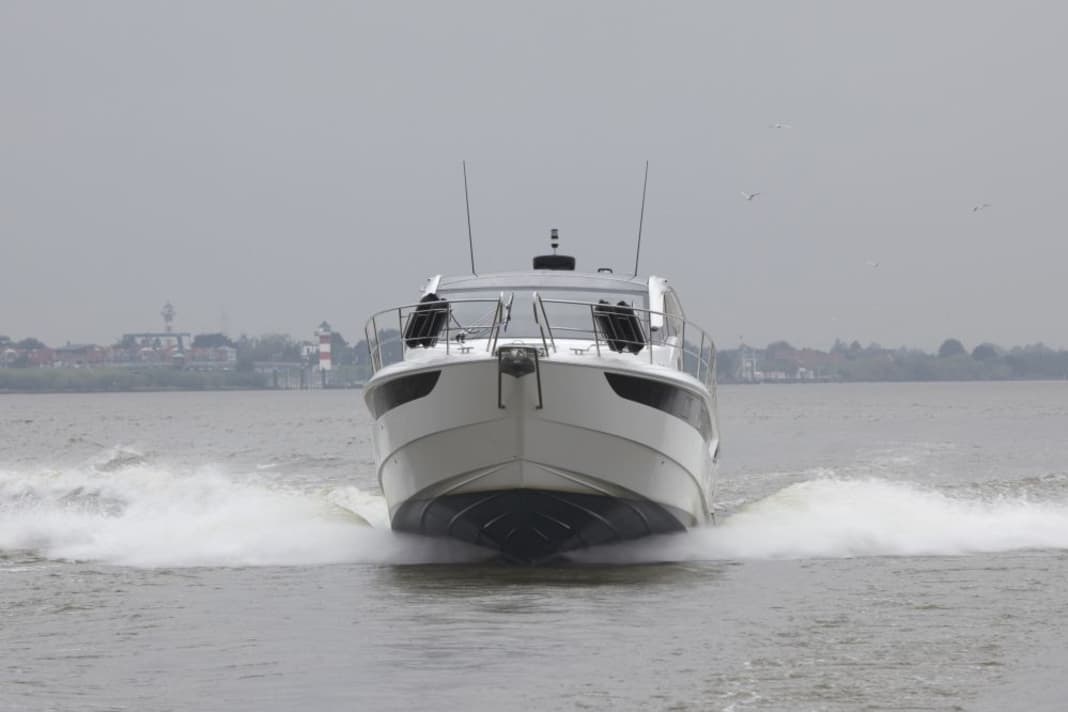







The number of berths is important for a larger crew, whether relatives or friends. Our test boat, the Galeon 430 HTC, has six of these in three cabins: the bow and underfloor cabins (port side) are each equipped with double beds and a further cabin on the starboard side with two single beds. A version with just two sleeping cabins (standard version) is also possible.
The bow cabin of our test boat is intended for the owner or charter skipper, who will find a firmly upholstered but not ventilated berth. There is plenty of storage space and shelves. Side windows and a large ceiling window (with blinds) provide plenty of light, while side portholes and an emergency hatch in the cabin roof provide fresh air.
The forward cabin has a separate wet room with an electric pump toilet and a shower with a glass partition and a bench. Shortcoming: The distance between the shower wall and toilet is only wide enough. In this respect, guests in the two underfloor cabins have it better: although their bathroom is slightly smaller, the space at the toilet is more generous due to the layout without an extra shower room. This well-ventilated wet room can be accessed from the centre aisle, as can the two underfloor cabins, which have suitable storage space, good ventilation and firm cushions.
Driving, cooking and eating take place one floor up in the saloon, which not only offers an unrestricted all-round view, but also guarantees a real open-air experience with its sliding roof and ceiling floodlights, or rather light from above. The skylights are fitted with blinds to keep the temperature down in intense sunlight.
The cook works on a pantry block with two ceramic hobs, sink (1 ½ stainless steel bowl), 130-litre refrigerator with freezer compartment, sufficient work surface and storage space. The dishwasher holds crockery for six people. The seating area consists of a well-padded U-shaped bench (convertible into a berth) and two stools (can be pulled out of the seating unit on the port side). The folding table is also variable: when folded up, it keeps the passageway clear and can be doubled in size for dining in no time at all.
The aft section of the U-shaped bench has a special feature: when the sliding glass door is pushed all the way to port, it can be rotated into the cockpit, where it extends the seating area consisting of the L-shaped aft bench and free-standing table. This bench can be pushed forwards and backwards as required (larger bathing platform or more space in the cockpit). The non-slip platform is easily accessed via the rear entrance with door. Bathing comfort is provided by the stern shower and long bathing ladder - although the latter is located under a literally weighty flap that is difficult to fold up from the water.
Lifting the engine compartment lid is easy with two gas dampers in the cockpit. A ladder (fitted as standard) makes it easy to climb down into the engine compartment; two D4 Volvos are located under the cockpit floor in the rear bench area. Daily visual inspections can be carried out easily and service work (on the side of the engines) is sufficiently simple. The boat builders laid the cables and hoses firmly and neatly with cable ties, clamps, protective conduit or in the cable duct.
The well-equipped fuel system consists of two 550-litre nirotanks firmly bolted together with lugs, a stopcock, hose lines with two screw clamps on the connections and two diesel filters with sight glass and drain cock. In the electrical system, the batteries are safely housed in ventilated boxes, while the automatic machines are easily accessible in the switch cabinet at the saloon entrance. A 230 V shore connection with battery charger is standard; an inverter or generator for cooking on the ceramic hob or running the dishwasher at the mooring costs extra.
To leave the anchorage, simply operate the standard electric winch, start the two diesels and shift gears with ease using Volvo Penta's EVC gearstick. At idle, the two diesels turn 650 rpm and the Galeon pushes through the water at just under 5 knots. To prevent the stern wave from reaching a height that threatens the shore, the engines should not be allowed to exceed 1200 rpm (around 7 knots). The two 550-litre tanks, minus 15% reserve, are sufficient for about 900 nm in this situation. At an economical planing speed of 3000 rpm at just under 21 knots and 3.61 l/sm, the tank filling is sufficient for about 270 nm, which is an acceptable value for such a fast motor yacht. At full throttle (3500 rpm), the speed is 26 knots and over 4 litres/sm run through the fuel line - a range of a good 230 nm.
To ensure that the fast journey does not turn into a noisy, annoying trip, the shipyard carefully covers the engine compartment with fireproof aluminium foil foam insulation. The maximum noise level of 74 dB/A measured at the helm at full throttle shows that the engineers have done a good job here, and the trim tabs are used to bring the test boat into the optimum position at slow planing speed. At full throttle, you no longer need them, raise them all the way up and lift the sterndrives a little. If you pull into tight circles at full speed, the 430 HTC lies on its side as normal, turns its laps safely and swings easily into its own wave. Good handling is also evident on slalom courses and during abrupt steering movements with the always smooth hydraulic steering.
The test area was the Elbe at Grünendeich, just outside Hamburg. There is a lot of shipping traffic here, which sometimes causes a lot of choppy water. In the stern sea of two oncoming container ships, the Galeon's hull settles on course, smoothly and without much spray. Back at the jetty in Grünendeich, the boat can be driven to the jetty without any problems. This is made possible by the direct steering behaviour with two gearboxes engaged in opposite directions and the bow and stern thrusters (extra), and the shipyard has installed a gear lever, joystick and steering wheel at the helm to make operation child's play.
The driver sits on a firmly upholstered double bench that can be pushed forwards and backwards and therefore offers plenty of knee room. The feet rest on two footrests and the front passenger holds on to a leather-covered stainless steel handle. The driver looks through safety glass, which has two huge windscreen wipers on the windscreen. When seated, the view is passable, but standing drivers have to lean down at times. Apart from minor reflections, the skipper has a good view of the instruments in all driving situations.
The switches on a self-explanatory panel to the left of the steering wheel are also user-friendly. As standard safety equipment, the shipyard provides a fire extinguishing system, plenty of bilge pumps, non-slip structures and railings, which are just as solid and professional as the workmanship (see also the shipyard report on page 120) Conclusion: The Galeon 430 HTC (three-cabin version) is a successful, fast motor yacht for six people, which achieves good performance with the smallest possible motorisation.
Data sheet: Galeon 430 HTC
Shipyard: Galeon Boats
Type designation: Galeon 430 HTC
CE category: B - Outside coastal waters
Material of hull and deck: Plastic
Length: 13,25 m
Width: 4,16 m
Displacement: 12,00 t
Price: 378.600,00 €


